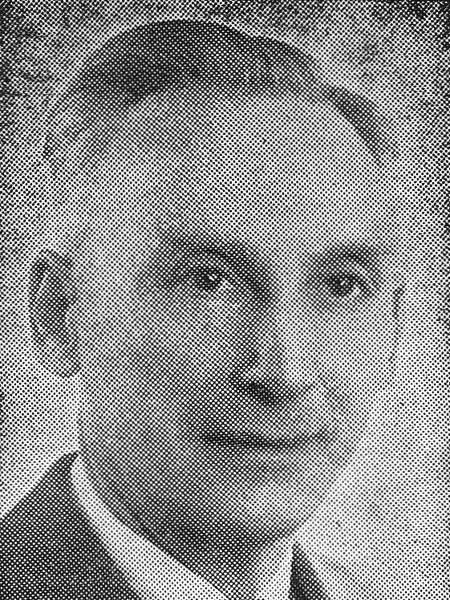 |
Harold V. West
|
Telegraph operator, credit union leader.
Born at Windsor Junction, Nova Scotia on 27 April 1897, his ancestors arrived in Canada in 1751 and 1752, and were founding families of Lunenburg. By 1914, he was working as a telegraph operator for the Canadian Government Railways in Nova Scotia. He soon headed to the prairies, working in northern Alberta with the Grand Trunk Pacific Telegraph Company, which was later absorbed by the Canadian National Telegraph systems. In June 1917, he joined the Royal Naval Canadian Volunteer Reserve, serving as a signalman aboard the Niobe and Stadacona. On 6 December 1917, he witnessed the great Halifax Explosion.
West returned to western Canada after the First World War. In 1923, he met MayBelle Gordon from Oxford, Nova Scotia, while they were both working at the CNR telegraph office at Regina. They were married the following year. They moved to Winnipeg in 1933, where Harold remained employed with the railway, and they raised a family and were active members of Broadway First Baptist Church. In 1963, he was involved in establishment of a Winnipeg chapter of the Morse Telegraph Club. He maintained his dedication to the Club, often speaking to the members and to the public on the history and significance of Samuel Morse and the telegraph.
He traveled regularly across North America throughout his four years as District Chairman and then as General Chairman of the Commercial Telegraphers Trade Union of North America. In 1948, he was involved with the historic Manitoba Union Institute conducted by the Winnipeg Labour Council and the Canadian Congress of Labour, serving as a Resource Leader for instruction in Co-operatives and Credit Unions. This educational conference was considered “the first of its kind in Western Canada.” That same year, his concern over the lack of adequate facilities for amateur and professional sports in Winnipeg led him to establish the Greater Winnipeg Co-operative Sports Society Ltd. Chartered in March 1949, with West as President, membership shares purchased by the general public provided capital in return for ownership, with operations managed by a board of directors. The initiative was stalled by the great 1950 flood and further challenges, including a post-war moratorium on steel for recreational facilities and a major railway strike, proved insurmountable and the cooperative’s operations were suspended.
He had a long-standing connection to the credit union movement in Manitoba. In 1939, he was elected to the board of directors of the Commercial Telegraphers Credit Union (CTCU), Manitoba’s third credit union and its first industrial or occupational credit union. He served for 10 years on the board, including two years as President. He became the CTCU’s part-time manager in 1945 and the credit union operated from his residence at 240 Garfield Street before eventually moving to the Nanton Building at 201 Portage Avenue, the home of Canadian National Telegraphs. He eventually resigned from CNR to become the CTCU’s full-time manager in 1951, retiring in 1968. Returning to the board, he remained a CTCU director until his death.
In 1947, he became a consultant in the organizational stages of The Winnipeg Citizen Co-operative Publishing Company, the first co-operative newspaper in North America. Also in 1947, he was a charter member of the Co-op Toastmasters Club. He played a key role in the passing of Manitoba’s Credit Union Act in 1950. A strong promoter of “the credit union philosophy,” he worked toward the establishment in 1946 of Manitoba’s first provincial education and service organization for credit unions (the Credit Union Federation in Manitoba). He served as its first managing director. Many of the founding meetings were held in his home. After the Federation’s amalgamation with the Manitoba Central Credit Union in 1950, he served on the board of directors of the new Cooperative Credit Society of Manitoba, then on the board of directors of the Credit Union League of Manitoba into the mid 1960s, and as its President in 1961. A director of the Credit Union National Association (CUNA) and a senior member of the CUNA Founders’ Club, he organized several credit unions and assisted others in their ongoing development. He wrote several booklets and pamphlets on Credit Unions. In 1953, he was a charter member of the Service Credit Union, today known as the Cambrian Credit Union.
He died at Winnipeg on 14 December 1975.
This page was prepared by Wendy Hart.
Page revised: 5 December 2025
Memorable Manitobans
This is a collection of noteworthy Manitobans from the past, compiled by the Manitoba Historical Society. We acknowledge that the collection contains both reputable and disreputable people. All are worth remembering as a lesson to future generations.
Search the collection by word or phrase, name, place, occupation or other text:
Custom SearchBrowse surnames beginning with:
A | B | C | D | E | F | G | H | I | J | K | L | M | N | O | P | Q | R | S | T | U | V | W | Y | ZBrowse deaths occurring in:
1975 | 1976 | 1977 | 1978 | 1979 | 1980 | 1981 | 1982 | 1983 | 1984 | 1985 | 1986 | 1987 | 1988 | 1989 | 1990 | 1991 | 1992 | 1993 | 1994 | 1995 | 1996 | 1997 | 1998 | 1999 | 2000 | 2001 | 2002 | 2003 | 2004 | 2005 | 2006 | 2007 | 2008 | 2009 | 2010 | 2011 | 2012 | 2013 | 2014 | 2015 | 2016 | 2017 | 2018 | 2019 | 2020 | 2021 | 2022 | 2023 | 2024 | 2025
Send corrections and additions to this page
to the Memorable Manitobans Administrator at biographies@mhs.mb.caCriteria for Memorable Manitobans | Suggest a Memorable Manitoban | Firsts | Acknowledgements
Help us keep
history alive!